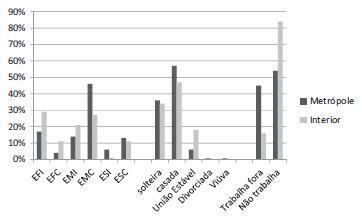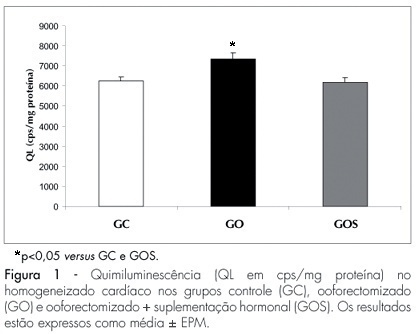Summary
Revista Brasileira de Ginecologia e Obstetrícia. 2012;34(6):268-273
DOI 10.1590/S0100-72032012000600005
PURPOSE: To evaluate the correlation between maternal waist circumference measured before the 12th week of gestation and serum leptin levels during pregnancy, as well as to compare the leptin levels of women with and without abdominal obesity diagnosed in early pregnancy. METHODS: Prospective study including 40 pregnant women receiving low-risk prenatal care, older than 20 years, nonsmokers, with singleton pregnancies and without chronic disease. Waist circumference was measured before the 12th week and serum leptin levels were measured between the 9th and 12th, 25th and 28th and 34th and 37th weeks of gestation. According to waist circumference measurement, the cohort was divided into two groups: with and without abdominal obesity. The Mann-Whitney and χ² tests were used to assess the differences between groups. The Pearson correlation coeffient was used to assess the association between waist circumference and serum leptin levels during pregnancy. The level of significance was set at p<0.05. RESULTS: The mean weight and body mass index of patients with abdominal obesity (74.4±11.0 kg/28.9±4.1) was higher than that of patients without abdominal obesity (55.6±5.9 kg/21.1±2.4) (p=0.001). The mean leptin levels in pregnant patients with abdominal obesity (41.9±3.5 ng/mL) was higher than in patients without abdominal obesity (23.6±2.7 ng/mL) (p<0.0002). A positive correlation was obtained between the waist circumference measured during the same period and the mean serum leptin levels (r=0.7; p<0.0001). CONCLUSIONS: Waist circumference measured before the 12th week of pregnancy is a valid and simple method to predict the serum leptin levels throughout pregnancy. Pregnant women with abdominal obesity diagnosed before 12th week have higher mean serum leptin levels during pregnancy than those without abdominal obesity.

Summary
Revista Brasileira de Ginecologia e Obstetrícia. 2005;27(5):268-274
DOI 10.1590/S0100-72032005000500007
PURPOSES: to analyze the frequency, associated risk factors for the occurrence of spina bifida and differences between the newborns carrying this malformation and the newborns' morbidities. METHODS: data were obtained through interview of 47 cases and 47 controls, born in the five maternities of the city of Pelotas, during the period from January 1, 1990 to December 31, 2003. This is a population-based case-control study, comprising all births occurred in hospitals. The control was the normal newborn that was born after each case with spina bifida. All data were obtained by using the model ECLAMC questionnaire. The planning of analysis of data included the use of the Student's t test, chi² and odds ratio. RESULTS: in this period there were approximately 77,000 births. Of these, 1,043 (1.35%) presented some type of congenital malformation. Among these, 47 of 162 anomalies of the neural tube (29%) were spina bifida cases. Significant differences have been found in the number of previous stillborn babies, as well as a higher rate of spina bifida cases in females. In this study, many factors such as the use of medical drugs; acute and chronic illnesses; number of gestations; age, education and occupation of the parents, among others, did not influence the occurrence of spina bifida. CONCLUSIONS: spina bifida must be considered as an important factor of risk for perinatal morbidity, and its occurrence is associated with a history of previous stillborn babies.
Summary
Revista Brasileira de Ginecologia e Obstetrícia. 2014;36(6):269-275
DOI 10.1590/S0100-720320140004907
To determine the agreement between the information on pregnant cards and on primary care medical records about prenatal assistance in the city of Vitória, Espírito Santo, Brazil.
A population study of 360 puerperal women living in this city was interviewed at three hospitals where the cards were copied. Prenatal care data were collected by reviewing the medical records at the city health unit. The information was collected, processed, and submitted to Kappa, Adjusted Kappa, and McNemar tests to check agreement and tendency to disagreement between the cards and the medical records.
The levels of agreement within prenatal care were predominantly moderate (Kappa=0.4-0.6). There was a higher tendency to keep records of appointments on the cards (McNemar=22.3; p-value<0.01). Records of supplementation with folic acid and ferrous sulphate were kept more often on the medical records (McNemar=70.8 and 69.8, respectively; p-value<0.01). The tetanus vaccination coverage was about 50%. Clinical and obstetric procedures and laboratory tests were primarily recorded on the card.
The medical records of primary care were underused as a tool for communication among health professionals, highlighting a precarious record keeping. The results suggest that thought be given to guarantee that the minimum procedures established by the Guidelines of Maternal and Infant Health are followed, and also to the importance of clinical record keeping in health services, since there is variation depending on the source of information.
Summary
Revista Brasileira de Ginecologia e Obstetrícia. 2004;26(4):269-275
DOI 10.1590/S0100-72032004000400002
OBJECTIVE: to evaluate the performance of Pap smear, hybrid capture II (HC II), and visual inspection with acetic acid in the detection of pre-invasive and invasive cervical lesions. METHODS: a total of 2281 women were submitted to a clinical exam, including Pap smear, HC II for HPV DNA detection and visual inspection with 5% acetic acid (VIA). When at least one of the tests was positive, colposcopy was performed and targeted biopsies were taken from suspicious lesions. Colposcopy was also performed in 420 women with negative results. Test performance was evaluated, using colposcopy as the gold standard, with or without biopsy. RESULTS: Pap smear, VIA and HC II were positive in 9.2, 10.9 and 17.5% of all women screened, respectively. Although at least one positive test was found in 671 women (29.4%), only 82 (3.6%) presented histologically confirmed disease (50 NIC1, 20 NIC2, 7 NIC3, and 5 invasive carcinoma). VIA and HC II sensitivities were similar and significantly higher than Pap smear. Pap smear showed better specificity than VIA and than HC II. In women with a negative Pap smear result, VIA showed better performance than HC II. CONCLUSION: Pap smear combined with VIA performed better than Pap smear combined with HC II or than Pap smear alone.
Summary
Revista Brasileira de Ginecologia e Obstetrícia. 2016;38(1):27-34
To determine differences in some nutritional aspects of pregnant women assisted at prenatal care services in a country town and in a metropolitan area.
Pregnant women received prenatal care in the city of Belo Horizonte (BH), metropolitan area, and Paula Cândido (PC), a country town. A Food Frequency Questionnaire (FFQ) containing socioeconomic information and information about eating habits was applied. In addition,weight and height were measured on the occasion of the visits and the women were ask to give their prepregnancy weight for subsequent BMI calculation. Data were analyzed according to region and trimester of pregnancy using the SPSS software version 15.0, the t-test to compare averages and the chi-square test of independence, with the level of significance set at 5%.
240 pregnant women were included, 90 fromthe country town and 150 from themetropolitan area. Of these,most weremarried (BH = 56.6%; PC = 46.6%) and did not work outside the home (BH = 54.0%; PC = 84.4%). They predominantly had 3-4 meals/ day during the 1st and 2nd quarters (BH = 54.0 and 46%; PC = 66.7 and 63.3%, respectively) and had 5-6 meals/day during Q3 in BH (44%). There was significant weight gain only in the 1st quarter (BH: 58,0%; PC: 53.3%). Weight gain versus eating habits was significant for the variables "lunch or dinner away from home" for the 1st quarter in BH (p = 0.006), "How many times they consume milk" in the 1 st quarter in PC (p = 0.03), and "How many times they consume junk food" in the 3rd quarter in BH (p = 0.009).
Pregnant woman showed proper eating habits in both regions despite the prevalence of pregestational overweight in BH and a low level of education and income, especially in the country town, an indicator that may be unfavorable for the nutrition of pregnant women during this period. Studies of association between eating habits and newborn health will provide more information about nutrition during pregnancy.

Summary
Revista Brasileira de Ginecologia e Obstetrícia. 2000;22(1):27-32
DOI 10.1590/S0100-72032000000100005
Purpose: to identify and quantify the underreporting of maternal mortality, from death certificates (DC) in Campinas, São Paulo, from 1992 to 1994. Methods: a total of 216 DC whose causes of death were maternal (declared and/or presumed) were selected among the 1032 DC of 10 to 49-year-old women. A complementary investigation was performed on hospital records, at the death verifying units, and in households. Results: eight additional maternal deaths were identified among the 204 DC with presumed maternal death. This corresponded to an underreporting rate of 40% or to a correction factor of 1.67 for the official MMR. The first cause of underreporting was abortion (71.5% or 05/07) and indirect maternal deaths represented the second cause (66.6% or 02/03). Conclusions: the death certificate cannot be considered the only source to identify maternal death. Complementary investigation of the presumable causes of maternal death should be performed. Legislation, social and religious factors might influence the underreporting of abortion as the cause of maternal death.
Summary
Revista Brasileira de Ginecologia e Obstetrícia. 2013;35(1):27-32
DOI 10.1590/S0100-72032013000100006
PURPOSE: To compare and analyze socioeconomic aspects and the emotional experience of women with spontaneous or induced abortion and in women living in the outskirts of São Paulo. METHODS: A prospective case-control study carried out from July 2008 to March 2010, involving semi-structured interviews with women who presented a previous diagnosis of abortion and who had been admitted to two public hospitals in the outskirts of São Paulo. The study included 100 women with diagnosis of abortion and were hospitalized for curettage. Eleven women who reported induced abortion (11%) represented the case group. The control group (n=22) was selected at a 2:1 ratio according to the following procedure: for every case of induced abortion, the next two cases of spontaneous abortion at the same hospital. A semistructured interview was conducted with questions regarding emotional aspects and family, social and economic context. RESULTS: The women with induced abortion compared to the group with spontaneous abortion had lower educational level, with more frequent elementary level (82 versus 36%, p=0.04), lower income (median, R$ 1,000.00 versus R$ 1,400.00, p=0.04), lower personal income (median, R$ 200.00 versus R$ 333.00, p=0.04), higher frequency of negative feelings upon suspicion (82 versus 22%, p=0.004) and confirmation (72 versus 22%, p=0.03) of pregnancy. CONCLUSION: Among women looking for health care in hospitals in the outskirts of São Paulo, induced abortion is related to unfavorable socioeconomic conditions, which affects the emotional experiences of suspicion and confirmation of pregnancy.
Summary
Revista Brasileira de Ginecologia e Obstetrícia. 2007;29(1):27-33
DOI 10.1590/S0100-72032007000100005
PURPOSE: to evaluate oxidative stress in cardiac tissue of ovariectomized rats, with and without hormonal therapy. METHODS: female Wistar rats were divided in three groups: control group (CG); ovariectomized group (OG); ovariectomized group with estrogen supplementation (ESG). The estrogen deprivation was done through bilateral ovariectomy. After one week from the ovariectomy, a pellet of 1.5 mg of 17beta-estradiol was implanted in the ESG animals. Nine weeks after the ovariectomy, cardiac tissue was obtained for the analysis of the oxidative stress through CL (chemiluminescence), and measurement of antioxidant enzymes catalase (CAT), superoxide dismutase (SOD) and gluthatione peroxidase (GPx). RESULTS: CL was increased in the OG (7348±312 cps/mg protein) when compared with the CG (6250±41 cps/mg protein, p<0.01), but there was no significant difference between the CG and the ESG (6170±237 cps/mg protein). Ovariectomy reduced SOD (35%, p<0.05) and CAT (22%, p<0.001) activities in the OG as compared with the CG. Hormonal therapy normalized antioxidant enzymes activities in the ESG. There was no statistically significant difference in GPx activity among the groups studied. CONCLUSIONS: ovarian hormone deprivation induced an increase of oxidative stress with reduction of antioxidant defenses in the cardiac tissue. However, hormonal therapy prevented oxidative stress after ovariectomy, probably due to an increase of the CAT and SOD activities in the cardiac muscle. These findings suggest an important oxidative stress contribution in cardiovascular dysfunctions observed in women after menopause, reinforcing the importance of hormonal therapy in the management of cardiovascular diseases risk in this group of women.
